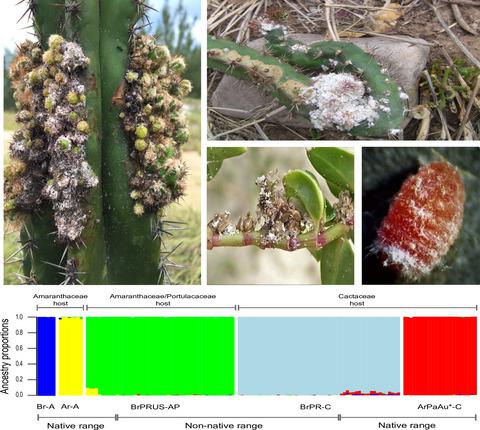当前位置:
X-MOL 学术
›
Ecol. Evol.
›
论文详情
Our official English website, www.x-mol.net, welcomes your
feedback! (Note: you will need to create a separate account there.)
Species complex diversification by host plant use in an herbivorous insect: The source of Puerto Rican cactus mealybug pest and implications for biological control
Ecology and Evolution ( IF 2.3 ) Pub Date : 2020-08-20 , DOI: 10.1002/ece3.6702 Daniel Poveda-Martínez 1, 2, 3, 4 , María Belén Aguirre 1, 3 , Guillermo Logarzo 1 , Stephen D Hight 5 , Serguei Triapitsyn 6 , Hilda Diaz-Sotero 7 , Marcelo Diniz Vitorino 8 , Esteban Hasson 2, 3
Ecology and Evolution ( IF 2.3 ) Pub Date : 2020-08-20 , DOI: 10.1002/ece3.6702 Daniel Poveda-Martínez 1, 2, 3, 4 , María Belén Aguirre 1, 3 , Guillermo Logarzo 1 , Stephen D Hight 5 , Serguei Triapitsyn 6 , Hilda Diaz-Sotero 7 , Marcelo Diniz Vitorino 8 , Esteban Hasson 2, 3
Affiliation

|
Cryptic taxa have often been observed in the form of host‐associated species that diverged as the result of adaptation to alternate host plants. Untangling cryptic diversity in species complexes that encompass invasive species is a mandatory task for pest management. Moreover, investigating the evolutionary history of a species complex may help to understand the drivers of their diversification. The mealybug Hypogeococcus pungens was believed to be a polyphagous species from South America and has been reported as a pest devastating native cacti in Puerto Rico, also threatening cactus diversity in the Caribbean and North America. There is neither certainty about the identity of the pest nor the source population from South America. Recent studies pointed to substantial genetic differentiation among local populations, suggesting that H. pungens is a species complex. In this study, we used a combination of genome‐wide SNPs and mtDNA variation to investigate species diversity within H. pungens sensu lato to establish host plant ranges of each one of the putative members of the complex, to evaluate whether the pattern of host plant association drove diversification in the species complex, and to determine the source population of the Puerto Rican cactus pest. Our results suggested that H. pungens comprises at least five different species, each one strongly associated with specific host plants. We also established that the Puerto Rican cactus pest derives from southeastern Brazilian mealybugs. This is an important achievement because it will help to design reliable strategies for biological control using natural enemies of the pest from its native range.
中文翻译:

食草昆虫寄主植物的物种复杂多样化:波多黎各仙人掌粉蚧害虫的来源及其对生物防治的影响
人们经常以宿主相关物种的形式观察到隐性类群,这些物种由于适应替代宿主植物而发生分化。解开包含入侵物种的物种复合体中的神秘多样性是害虫管理的一项强制性任务。此外,研究物种复合体的进化历史可能有助于了解其多样化的驱动因素。粉状地球菌Pungens被认为是来自南美洲的一种杂食性物种,据报道是一种破坏波多黎各本土仙人掌的害虫,也威胁到加勒比海和北美的仙人掌多样性。该害虫的身份和来自南美洲的来源种群都不确定。最近的研究指出当地种群之间存在显着的遗传差异,表明H. pungens是一个物种复合体。在这项研究中,我们利用全基因组 SNP 和 mtDNA 变异的组合来研究H. pungens sensu lato 内的物种多样性,以建立复合体中每个假定成员的寄主植物范围,以评估寄主植物的模式是否协会推动了物种复合体的多样化,并确定了波多黎各仙人掌害虫的来源种群。我们的结果表明H. pungens至少包含五种不同的物种,每一种都与特定的寄主植物密切相关。我们还确定波多黎各仙人掌害虫源自巴西东南部的粉蚧。这是一项重要的成就,因为它将有助于设计可靠的策略,利用害虫原生地的天敌进行生物防治。
更新日期:2020-10-12
中文翻译:

食草昆虫寄主植物的物种复杂多样化:波多黎各仙人掌粉蚧害虫的来源及其对生物防治的影响
人们经常以宿主相关物种的形式观察到隐性类群,这些物种由于适应替代宿主植物而发生分化。解开包含入侵物种的物种复合体中的神秘多样性是害虫管理的一项强制性任务。此外,研究物种复合体的进化历史可能有助于了解其多样化的驱动因素。粉状地球菌Pungens被认为是来自南美洲的一种杂食性物种,据报道是一种破坏波多黎各本土仙人掌的害虫,也威胁到加勒比海和北美的仙人掌多样性。该害虫的身份和来自南美洲的来源种群都不确定。最近的研究指出当地种群之间存在显着的遗传差异,表明H. pungens是一个物种复合体。在这项研究中,我们利用全基因组 SNP 和 mtDNA 变异的组合来研究H. pungens sensu lato 内的物种多样性,以建立复合体中每个假定成员的寄主植物范围,以评估寄主植物的模式是否协会推动了物种复合体的多样化,并确定了波多黎各仙人掌害虫的来源种群。我们的结果表明H. pungens至少包含五种不同的物种,每一种都与特定的寄主植物密切相关。我们还确定波多黎各仙人掌害虫源自巴西东南部的粉蚧。这是一项重要的成就,因为它将有助于设计可靠的策略,利用害虫原生地的天敌进行生物防治。











































 京公网安备 11010802027423号
京公网安备 11010802027423号